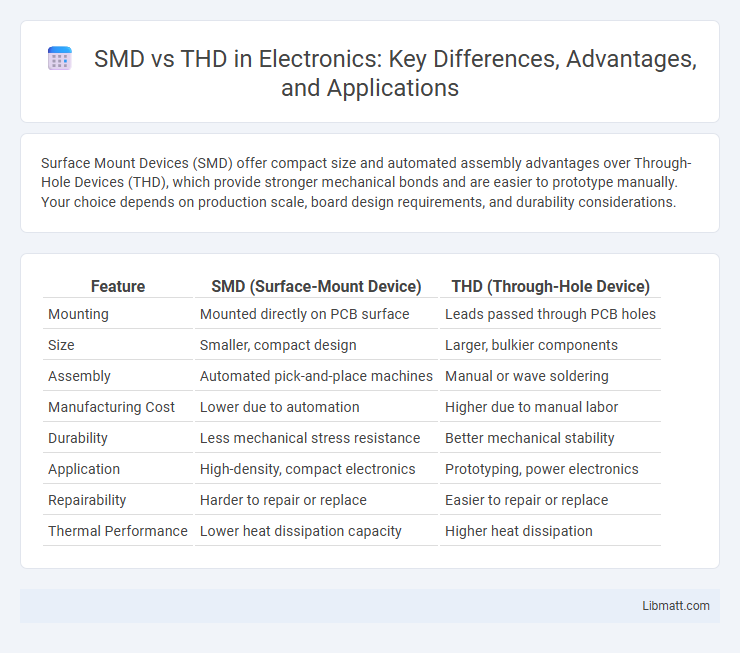Surface Mount Devices (SMD) offer compact size and automated assembly advantages over Through-Hole Devices (THD), which provide stronger mechanical bonds and are easier to prototype manually. Your choice depends on production scale, board design requirements, and durability considerations.
Table of Comparison
| Feature | SMD (Surface-Mount Device) | THD (Through-Hole Device) |
|---|---|---|
| Mounting | Mounted directly on PCB surface | Leads passed through PCB holes |
| Size | Smaller, compact design | Larger, bulkier components |
| Assembly | Automated pick-and-place machines | Manual or wave soldering |
| Manufacturing Cost | Lower due to automation | Higher due to manual labor |
| Durability | Less mechanical stress resistance | Better mechanical stability |
| Application | High-density, compact electronics | Prototyping, power electronics |
| Repairability | Harder to repair or replace | Easier to repair or replace |
| Thermal Performance | Lower heat dissipation capacity | Higher heat dissipation |
Introduction to SMD and THD Technologies
Surface-Mount Device (SMD) technology revolutionizes electronics assembly by enabling components to be mounted directly onto the surface of printed circuit boards, enhancing miniaturization and manufacturing efficiency. Through-Hole Device (THD) technology involves inserting component leads into drilled holes on a PCB, offering robust mechanical bonding suited for high-stress environments. Both SMD and THD technologies play critical roles in electronic design, with SMD favored for compact, high-speed applications and THD preferred for durability and ease of prototyping.
Defining SMD (Surface Mount Device)
Surface Mount Device (SMD) refers to electronic components designed for direct placement and soldering onto the surface of printed circuit boards (PCBs), offering lower profile and enhanced performance compared to through-hole devices (THD). SMD components enable higher circuit density, improved signal integrity, and automated manufacturing processes, making them ideal for modern electronics. Your projects benefit from compact design and reliable electrical connections when using SMD technology over traditional THD components.
Understanding THD (Through-Hole Device)
Through-Hole Devices (THD) feature leads that pass through PCB holes, providing superior mechanical strength and reliable electrical connections ideal for components like resistors and capacitors in high-stress environments. Compared to Surface-Mount Devices (SMD), THD offers easier prototyping and repair due to its through-board lead placement but results in larger assembly size and slower manufacturing processes. THD is preferred in applications requiring durability and high power handling, making it essential for aerospace, military, and industrial electronics.
Key Differences Between SMD and THD
SMD (Surface-Mount Device) and THD (Through-Hole Device) differ primarily in mounting techniques: SMD components are soldered directly onto the surface of PCBs, enabling compact designs and automated assembly, whereas THD components have leads inserted into holes and soldered on the opposite side, providing stronger mechanical bonds ideal for high-stress applications. SMD components offer higher component density and are suitable for high-frequency circuits due to shorter leads, while THD components are often preferred for prototypes or where durability and easy replacement matter. Your choice between SMD and THD depends on factors like board space, production volume, mechanical strength, and assembly method.
Manufacturing Process: SMD vs THD
Surface Mount Devices (SMD) are mounted directly onto the surface of printed circuit boards (PCBs) using automated placement machines, allowing for high-speed, precise, and compact manufacturing processes. Through-Hole Devices (THD) require component leads to be inserted into drilled holes on the PCB and soldered manually or with wave soldering, resulting in a more labor-intensive, time-consuming assembly. SMD technology enhances manufacturing efficiency and component density, while THD offers stronger mechanical bonds suitable for heavy or high-stress applications.
Performance Comparison: SMD and THD
SMD (Surface-Mount Devices) offer superior performance in high-frequency applications due to shorter lead lengths and reduced parasitic inductance compared to THD (Through-Hole Devices). THD components provide stronger mechanical bonds and better heat dissipation, making them preferable for high-power or mechanically stressed environments. Choosing between SMD and THD depends on your specific performance needs, such as compactness, signal integrity, or durability.
Applications and Use Cases
SMD (Surface-Mount Device) components are ideal for high-density applications such as smartphones, tablets, and wearable technology due to their compact size and automated assembly compatibility. THD (Through-Hole Device) components are preferred in power electronics, automotive, and aerospace industries where mechanical strength and durability under harsh conditions are critical. Your choice depends on specific use cases requiring either miniaturization and mass production or robust physical connections for reliability.
Cost Considerations
SMD (Surface-Mount Device) components typically reduce manufacturing costs due to automated assembly processes and smaller packaging, enabling higher production speeds and lower labor expenses compared to THD (Through-Hole Device) components. THD components often incur higher costs because they require manual insertion or more complex machinery, increasing time and labor intensity, which impacts overall production budgets. Your decision between SMD and THD should weigh these cost differences against product requirements and volume to optimize economic efficiency.
Advantages and Disadvantages
Surface Mount Devices (SMD) offer advantages such as smaller size, higher component density, and faster automated assembly compared to Through-Hole Devices (THD), which provide better mechanical strength and easier prototyping and manual soldering. SMD components are ideal for compact, high-speed electronic circuits but can be more challenging to repair, while THD components excel in durability and are better suited for high-power applications. Your choice depends on whether you prioritize manufacturing efficiency and miniaturization or mechanical robustness and ease of handling.
Choosing Between SMD and THD: Factors to Consider
Choosing between SMD (Surface-Mount Device) and THD (Through-Hole Device) depends on factors like PCB space constraints, mechanical strength requirements, and production volume. SMD components offer compact size and automated assembly benefits, ideal for high-density and mass production, while THD components provide stronger physical connections suited for prototypes or high-stress applications. Your decision should balance device reliability, manufacturing costs, and design complexity to optimize performance and efficiency.
SMD vs THD Infographic

 libmatt.com
libmatt.com